20 June Part dva
Finishing the morning with Mike
The previous post ended at the statue of Peter I in front of Mikhailovsky Castle but that wasn’t the end of our tour. We continued past the castle and crossed a small bridge to reach the Summer Garden that sits on its own small island. The garden was founded in 1704 by Peter the Great who was personally involved in its planning. The walkways were originally lined with over 100 marble sculptures. About 90 of those survived into the twentieth century but they were moved indoors to protect them from the vagaries of Saint Petersburg’s climate. The sculptures we saw (and that you will see in the pictures) are replicas. The fountains in the picture below are another prominent feature of the Summer Garden as are the Coffee House and the relatively modest sixteen room Summer Palace of Peter the Great all of which you can see here.
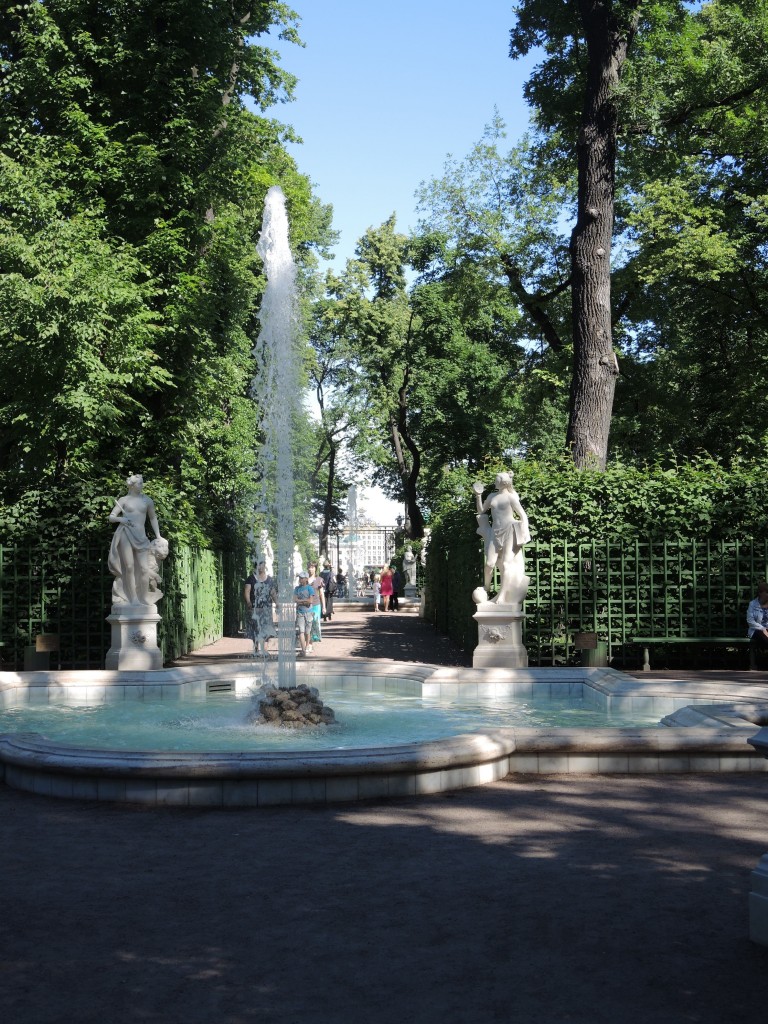
As you go through the pictures of the Summer Garden, you’ll see a picture of a monument to Ivan Krylov. Have you ever heard of him? I hadn’t but Mike told me a bit about him. He was born in the latter part of the eighteenth century and lived until the middle of the nineteenth. He moved to Saint Petersburg as a boy and became Russia’s best-known fabulist. He published his first collection of 23 fables around 1810 and, while they were largely based on the works of Aesop and La Fontaine, his later work was quite original. In fact, he is sometime called Russia’s La Fontaine. According to Mike, even today, students who wish to gain admission to any drama school in Russia must recite and enact one of Krylov’s fables as part of their application. This is a Krylov fable:
The Squirrel In Service
A Squirrel once served a Lion: I do not know how or in what capacity. But this much is certain, that the Squirrel’s service found favor in the Lion’s eyes; and to satisfy the Lion is, certainly, no easy task. In return for his service, the Lion promised the Squirrel a wagon full of nuts. The Squirrel toils on and time passes by but the wagon full of nuts remains only a promise. The Squirrel is often hungry. Though he grins in the Lion’s presence, he often has tears is his eyes. When the Squirrel looks around in the forest, he sees his former comrades feasting here and there high up among the trees. He stares at them but they keep happily cracking their nuts. Every time the Squirrel takes a step toward the nut bushes, the Lion calls or even drags him away to perform some task or another.
Look! Our Squirrel has grown old. He is no longer able to serve the Lion. It’s time for him to retire. The Lion grants him its discharge from service and gives him a wagon full of the most excellent nuts ever seen in the world. Each one is as perfect as the last. Sadly, the unlucky Squirrel had long ago lost all his teeth.
Still on Earth but in the Field of Mars
Our next stop is the Field of Mars. The earliest use of this space was as a training ground for guards’ regiments and parades. It was originally called the Tsarina’s Meadow for Peter the Great’s wife Catherine I. (Catherine II was “the Great”.) It acquired its current name in 1805. The field became a mass grave for nearly two hundred of those who died in the February Revolution of 1917 and a monument to the fighters of the revolution was built there. During the siege of Leningrad, (After the 1917 Revolution, Saint Petersburg was renamed Leningrad for a time.) the field was used as a vegetable garden to help feed the denizens of the city and it was returned to its use as a memorial after the war.
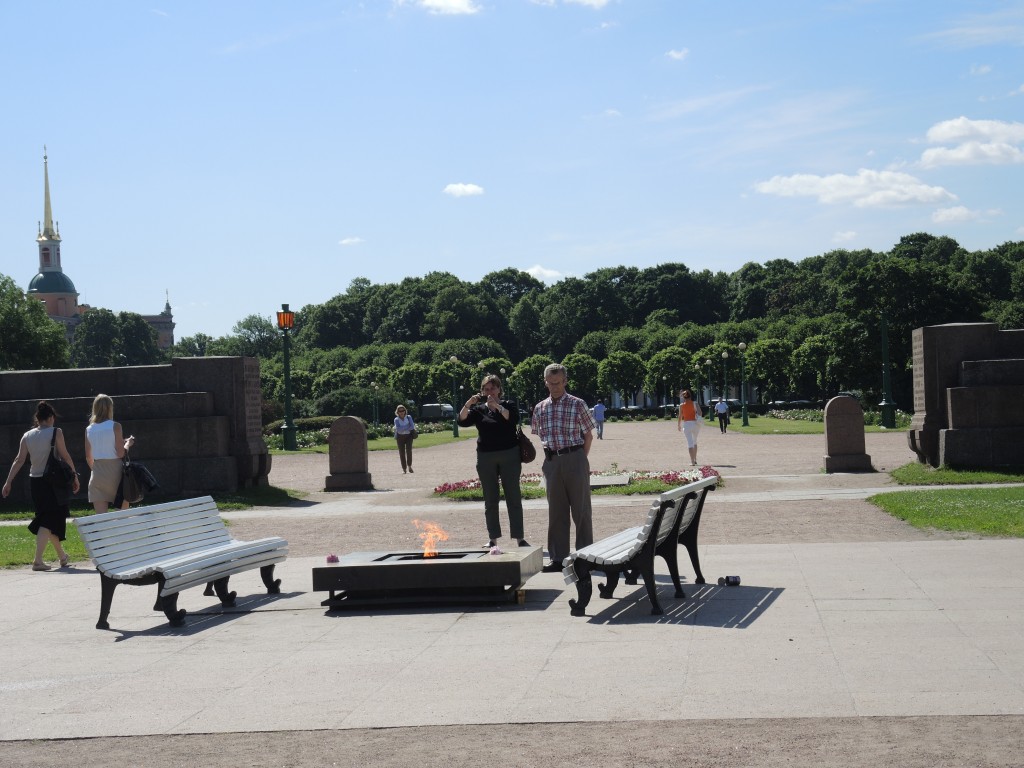
The eternal flame was lit in 1957 and was, according to Mike, the first of its kind in Russia.
Peering above and close to the Field of Mars is (and you’ve seen it in another photo in this album) the Church of the Savior on Spilled Blood. This church is visible throughout much of the old city and should not be confused with the similarly named church in Yekaterinburg. The blood spilled on this spot was that of Tsar Alexander II who was assassinated when a hand grenade was thrown into his carriage in 1881. (He was actually killed by a second device when he exited the bullet proof carriage that had been a gift from Napoleon III and had protected him from the initial blast.) Construction of the church – which appears to have drawn some inspiration from St. Basil’s – began in 1883 and was completed under the last Romanov Tsar, Nicholas II in 1907.
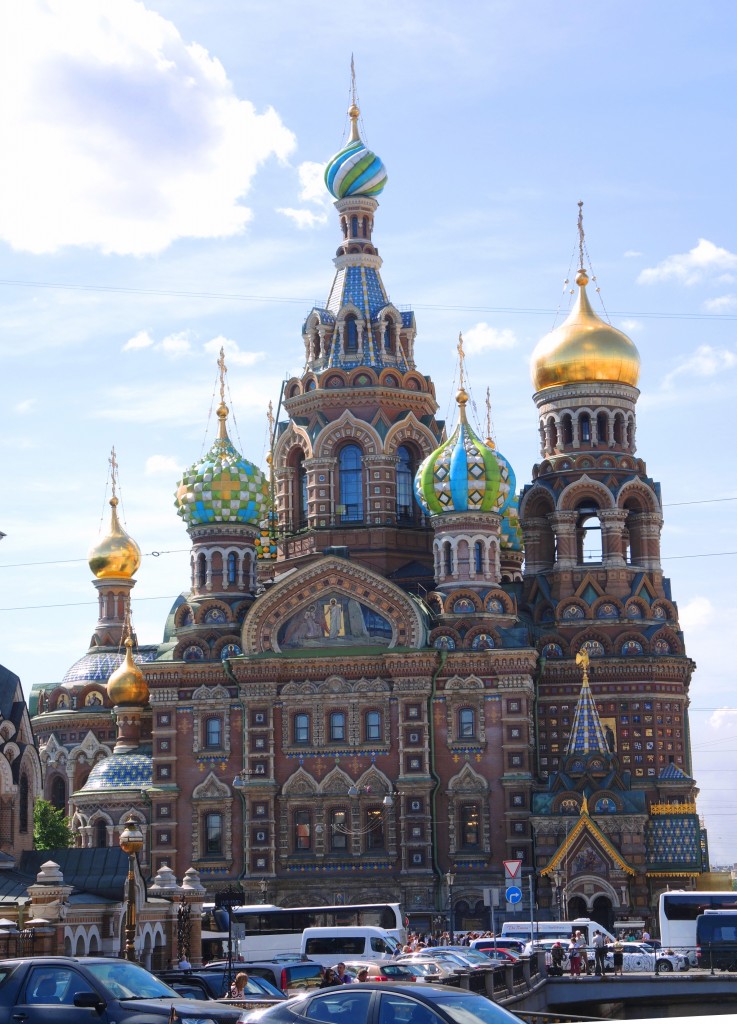
We walked on until we reached Palace Square. Here we encountered one of the very few downsides to being in Saint Petersburg during the White Nights – especially on the week of the solstice. Our views of the square were a bit corrupted by the stage that had been built for public performances. (John, Anne, and Groud would attend one of these later tonight.) Palace Square is home to the General Staff Building, the Alexander Column, and most famously the Winter Palace which is now part of the Hermitage Museum.
Catherine the Great ordered the construction of the Small Hermitage in the middle of the eighteenth century because living in and hosting parties and performances in Saint Petersburg’s winters was more practical in a small building than in the large Winter Palace.
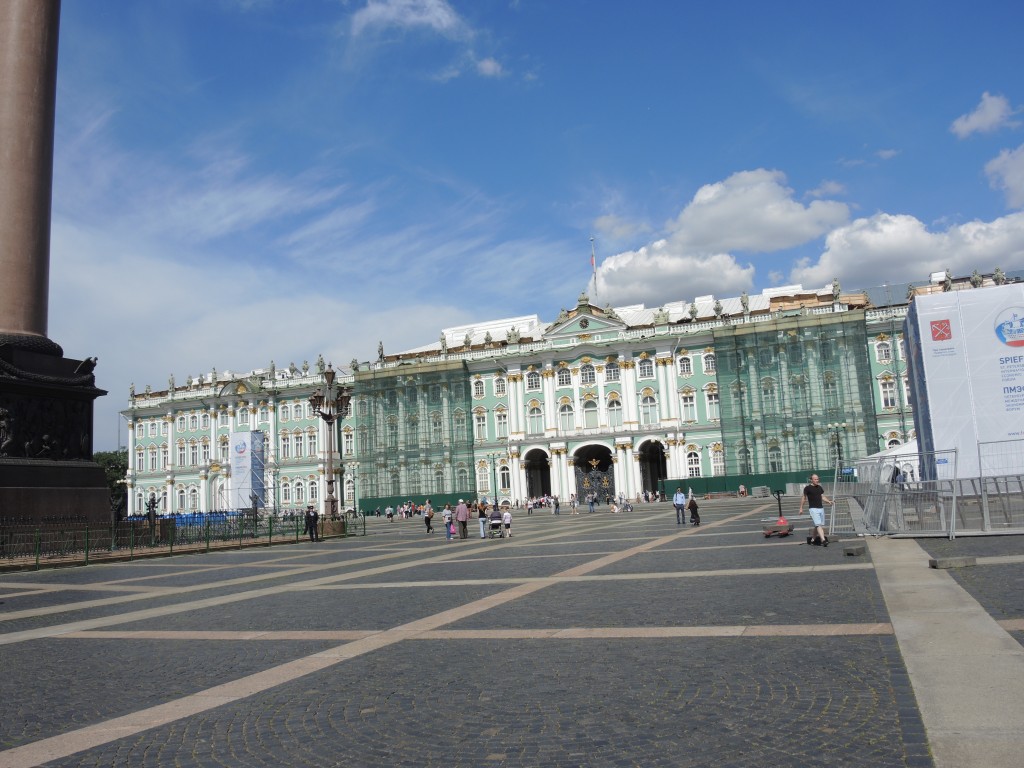
Though it originally only applied to the small buildings (there is a Southern Pavilion and a Northern Pavilion), the name Hermitage has now become the accepted way to refer to the entire complex of buildings that includes the Winter Palace and part of the General Staff Building.
At the center of Palace Square stands the rather remarkable Alexander Column.
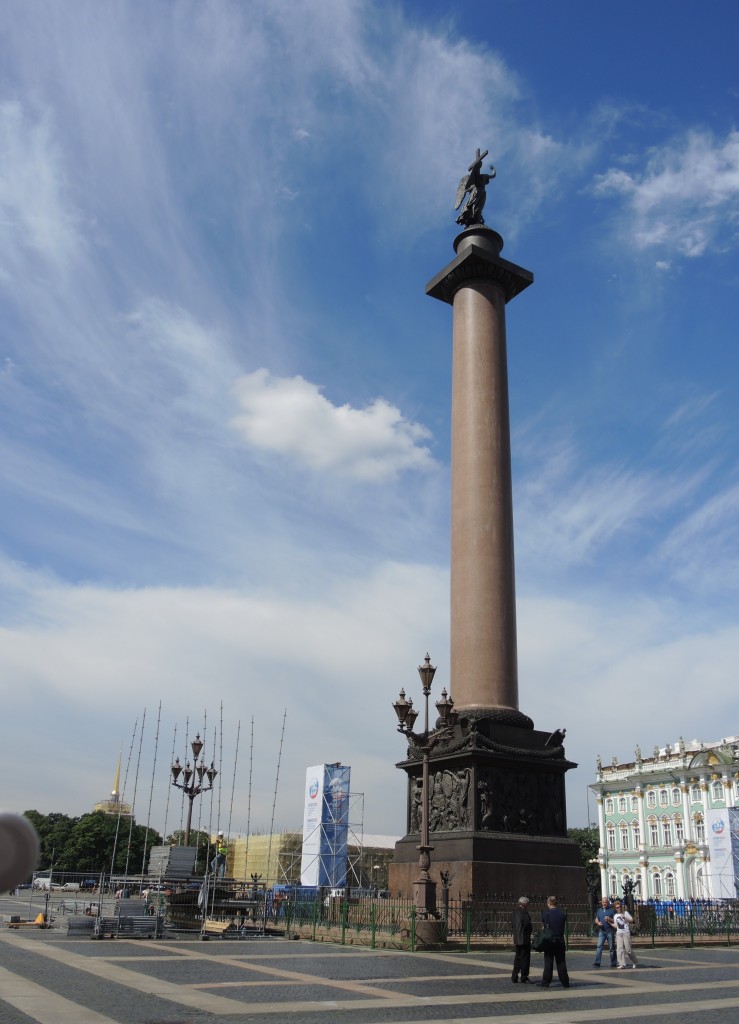
The monument stands 47.5 meters tall and is the tallest of its kind in the world. The column was placed on its pedestal in 1834 without the aid of any machinery. Even more remarkable, the column stands freely and is not attached to the base.
We ended the tour walking along the Neva River until we reached Senate Square. Under the Soviets, this was named Decembrist’s Square to commemorate the Decembrist Revolt of 1825 but has since taken on its more traditional moniker. One side of the square is bordered by the Senate and Synod Building constructed in 1834. The Senate was the highest legislative and administrative power in Russia while the Synod was the highest body in the Russian Orthodox Church. Peter the Great introduced the latter to replace the Patriarchy.
Situated in the square is the other famous monument to Peter the Great that I mentioned in the previous post. The Bronze Horseman. This work was commissioned by Catherine the Great who had married Peter III and who ascended to the throne following his somewhat mysterious death. She was German by birth and was suspected of being involved in Peter’s demise though that was never proved. She wanted to cement her ties to the Russian people and to Peter the Great, in particular, so she commissioned this statue.
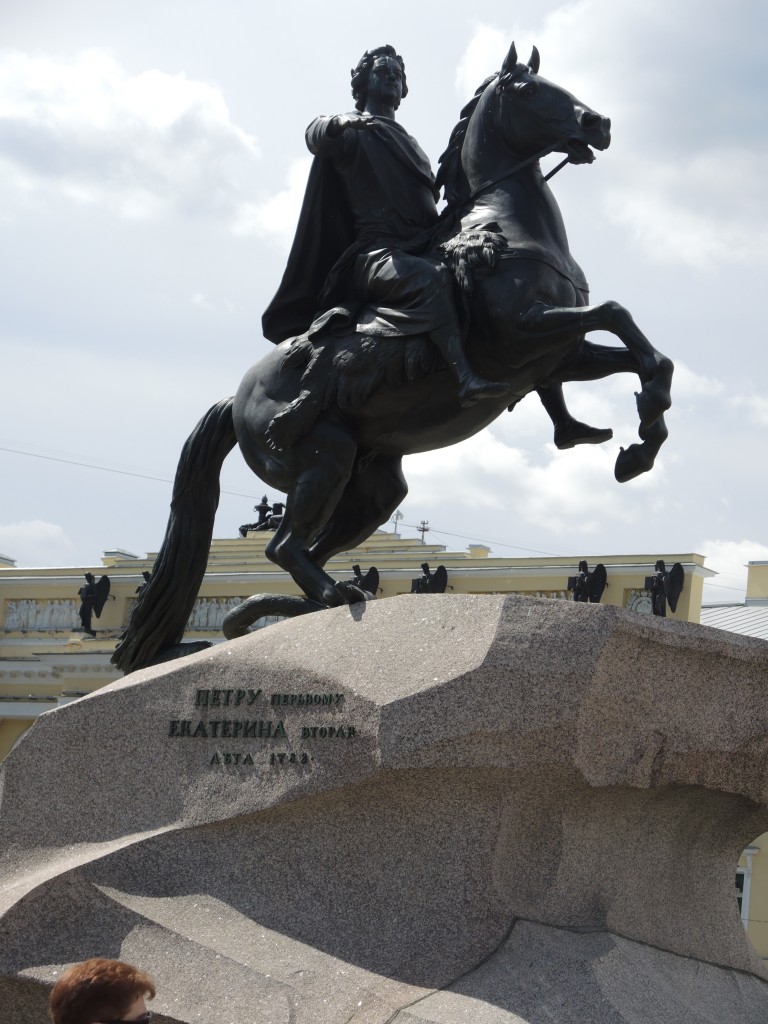
The base of the statue is called the Thunder Stone and weighs an estimated 1,250 tons. Not quite visible in the photo, Peter the Great’s horse is trampling a serpent. According to Mike, this addition arose as a result of a wager between the sculptor, Eteienne Falconet and some fellow artists who couldn’t imagine that the rearing horse could be properly anchored to the stone. When questioned, Falconet said that the serpent represents treachery or Peter’s enemies.
At the other end of the square is St. Isaac’s Cathedral. If it’s not the tallest structure in the old city, it is certainly one of the tallest. Reaching to just over 100 meters, it’s the highest point in this part of the city one can visit. I’ll have more to say about that in a later post. I’m barely halfway through the events of the day so please return as the adventure continues.